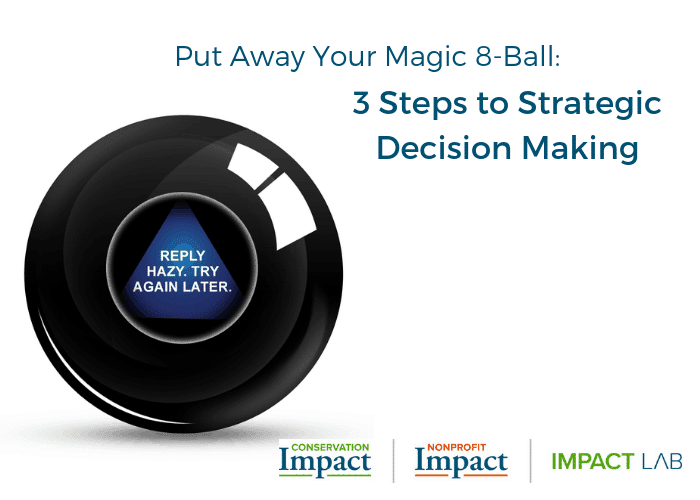
Put Away the Magic 8 Ball: Three Steps to Making Strategic Decisions
Making decisions is easy, right? It’s something we do all the time that takes little effort. Here’s real the scoop. Truly strategic decisions aren’t made willy-nilly. There are specific steps to making strategic decisions that are often overlooked.
People and organizations are best served by decision-making models that break down questions into feasible steps and result in thoughtful, deliberate choices. Here is one simple, but powerful three- step strategic decision-making model we use.
Step 1: Identify the actual decision to be made
Many of us tend to jump ahead to alternatives, what we think are foregone conclusions, instead of clearly identifying the specific decision we need to make. We’ve all watched meetings become unproductive quickly when emotions take over discussions that could be informed by data and facts. The group gets distracted from the real purpose of the meeting and spirals into past concerns or personal issues that may or may not relate to the decision at hand.
For example, consider an organization discussion that assesses it’s declining financial position. This could lead to emotional defenses of certain programs or projects. Yet, the actual decision that needs to be made is how to cut expenses (or increase revenue)—which may or may not include cutting programs or projects.
Step 2: Define parameters and objectives
Once the decision is clearly stated—for example, how will we cut expenses by ten percent—the second step is to establish objectives by which alternatives will be judged, often stated in terms of results, resources, and restrictions. Using the example, objectives might include making the reductions by the end of the fiscal year, keeping funder restrictions in place, or keeping key programs or projects whole. Then the group can discuss which objectives are absolute and which are just nice to have. Making the cuts by year end may be a necessity and keeping programs together might just be a nice thing to do, but not mandatory.
Step 3: Weigh the best options
Now, and only now, the discussion should move to alternatives. What choices do you have? Talk broadly about options so that several ideas can be tested against the objectives. Then narrow the options based on the decision needed and prioritized objectives. Select two or three that satisfy the most objectives and then consider the adverse consequences of these choices. Given this decision, what could go wrong? What’s a possible outcome that hasn’t been considered?
Using the Magic 8-Ball might seem easier. But when you use this model, the resulting decision is clearer and more acceptable to a larger group of stakeholders. This model can add time to the process, but for issues with a large impact on teams, programs, or organizations, it’s time well spent.

